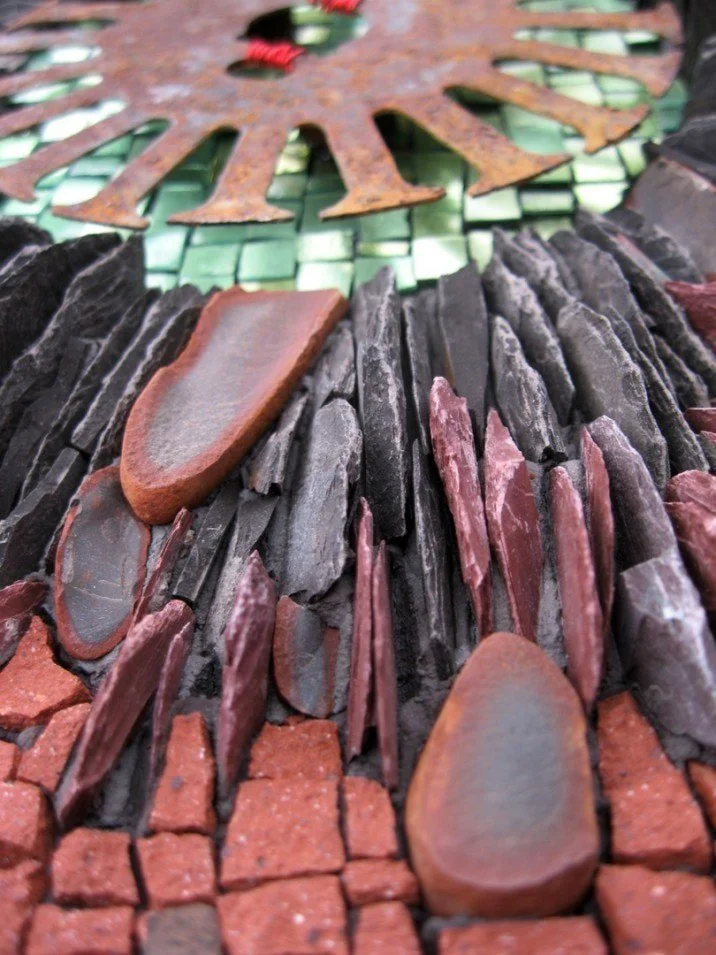Character appropriation
Being a good artist is hard. On the one hand, you have to learn the techniques of your medium to a point that you are at least proficient. On the other, you must discover ways to surprise or delight or yourself and the world. That’s called having a voice. A stamp. A flag. A fluttering banner that can be recognized from across the battlefield.
The angels and demons of social networking your business are such that on any given day, an artist’s hard work can be lauded as genius or critiqued as crap to the world. But there is another devil, lurking deeper in the shadows; the appropriator. I set the word appropriator apart from the word copier because mosaic has such a strong and storied history of copy. There’s the wonderful roman copy workshops that take a student painstakingly through a well-worn process that was honed centuries ago. Mosaic also comes from a past of skilled artisans who copied the cartoons of other’s visions. It has only been the last few decades that the “creator mosaicists” have jumped onto the stage and taken credit for their own unique voices.
“Maine” - Commission (2017)
I’ve listened to lots of artists talk about those moments when they see their work appropriated. Some words that come to mind to describe their reactions are abhorrence, shock, disdain, rage. I know, we’ve all heard the line, imitation is the sincerest form of flattery. And the old, good artists borrow, great artists steal. The latter, attributed to Picasso, rings true. The difference between stealing and borrowing is that when one steals, he makes the stolen thing his own. He has turned the thing inside out and upside down from what it was, until it a wholly new and different thing. I have awe for people who do that.
As a teacher, I am comfortable with a certain degree of student work being derivative. But I work hard to give students who spend time with me the freedom to transfer my techniques into their own personal practices. Speaking from a mosaic perspective, as I mostly do, it is a strange thing to work in a medium that requires time to slow down while living in a world that requires dizzying speed. It takes time to build a voice, to learn a technique, to get really good at anything. But at the same time, careers can be made in an Instagram minute. They can also be torn down by a well-timed tweet. Amidst this ampheta-mine-field landscape, mosaic quietly insists on the tortoise speed. I have yet to see a mosaic style (one that I like anyway) that can happen in the speed of a one-day-and-done collage.
“Apocryphal Topography” (2012)
To paraphrase a hard-working colleague: do your own work! I’m tired of doing all the heavy lifting and watching lazy artists feed off of my sweaty brow. Maybe you say, “come on, Rachel, this is the way the world works”. Touche. I must agree. But I write this for the audience out there who may care how I feel, as a working artist who makes 100% of her living from her craft. I do not respect you as you take too lazy shortcuts upon the shoulders of those you admire. I do not respect you as you skip obliviously over another’s lifetime of mistakes and experiments.
My work is my character. Every material I use, tesserae I cut and line I build is a direct reflection of my life story. Sometimes that story springs from the Appalachian dirt on which I was raised. More often than not, the stories I tell shine through my very personal tears and familial roots. When sharing that story with my students, I share it all. I decided from day one of becoming a teacher to be cut- throat in my generosity. I hold back no secrets, I give you every ounce of knowledge that I have scratched out of both my self-taught trials and my time learning from those above me.
“Oceanus Occidentalis” (2012)
There is no doubt that I have been influenced by my teachers, my peers and artists that I admire from afar. That’s an important step in the artistic process. But I have been vigilant to share with the world where I came upon any bit of genius that I chose to weave into my voice. If one skips this simple step, a line can be crossed. In this world of gentle praise in which we pillow our sensibilities, I believe there is a place for honest criticism of appropriating another’s signature. Do I lay myself across the railroad tracks as I risk drawing a line in the sand?
If yes, so be it. I would rather risk everything than quietly sit and let the train of appropriation flatten my banner.
All is fair in The War of Art.
(Credit to Stephen Pressfield for his title.)
“Fracture” (2011)
Sign up for the newsletter
You will receive one or two high quality blogs a month about anything from the state of contemporary mosaic, the power of dreams, the art of foraging to the latest updates on The Ruins.




